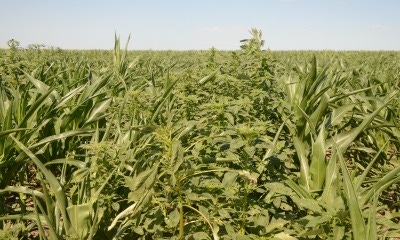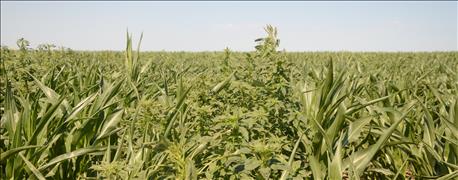
Palmer amaranth is what Jason Norsworthy calls the "ideal weed." In Arkansas, where he's from, it's infesting nearly 4 million acres, and more than 95% of the Palmer amaranth in Arkansas is glyphosate-resistant. It's growing in at least 30 states — including Nebraska — and it's literally put farmers out of business in some cases. Some researchers, including Norsworthy, a University of Arkansas weed scientist, have made a career out of fighting Palmer.

LIKE WILDFIRE: Palmer amaranth is a weed that spreads like wildfire — in several cases, it has literally put farmers in the Mid-South out of business, says Jason Norsworthy, a University of Arkansas weed scientist.
"Palmer is No. 1 in the U.S. in terms of being the most troublesome weed," according to a Weed Science Society of America survey, says Norsworthy. "There is some in Nebraska, but this is a weed that once it gets established, it spreads like wildfire."
At a recent Palmer Amaranth Field Day near Shickley, Norsworthy outlined some steps to take control of Palmer amaranth and mitigate the chances of resistance from developing — or at least slow it down.
One of the reasons Palmer is so prolific is that it has multiple terminal seed heads. This means it's competitive in the field with crops, but is also easy to spread through the combine. That's why it's imperative that growers remove female plants before they set seed.
Another factor is Palmer amaranth's emergence pattern. In Nebraska, Palmer can emerge from early May through the first week of September. So, control has to last all season.
It grows at a rate of about 0.75 inches to 1 inch per day for the first week and then 2.5 inches per day afterward. On average, a single plant produces 60,000 seeds, although some plants can produce upward of 1 million seeds.
A tough weed to control

ZERO-TOLERANCE POLICY: At a recent Palmer Amaranth Field Day near Shickley, University of Arkansas weed scientist Jason Norsworthy explained that when faced with Palmer amaranth — especially resistant Palmer amaranth — a "zero tolerance" policy is a must.
Palmer can thrive in a number of environments — including on concrete when spilled out of the back of a grain truck. It is easily transported in cottonseed hulls and combines, especially purchased out of the South.
That's why a "zero tolerance" policy is a must, especially when faced with a resistant Palmer amaranth population. "We've got to have complete control of it. Even one plant per 10 feet of row is going to reduce soybean yields by 17%," Norsworthy says. "With this weed, if you're not achieving complete control, if you allow 1% to survive in the field, you will quickly develop resistance to many of the herbicides you have."
It's something growers in Arkansas know about all too well. Some populations of Palmer amaranth in the state have resistance to as many as four different herbicide groups: stacked resistance to ALS-inhibitors, DNA, glyphosate and PPO-inhibitors.
But many growers in the Mid-South have adapted, using a burndown in late winter, followed by a preemerge application in spring, followed by a postemerge application with overlapping residuals. That's in corn. In soybeans, Norsworthy adds, growers are coming back two to three weeks later and applying another post to get the field to canopy. "If you're going to be successful, you're going to spend $80 to $90 per acre to grow soybeans. If not, you're going to be out of the soybean business," he says. "If you're going to be successful long-term, you're starting with no weeds at planting, and you're going to overlay residual herbicides."
Don't give Palmer a chance
These herbicides need to be applied at the right time, when weeds are the right size — most postemergence herbicides should be applied when weeds are less than 4 inches. The right rate also needs to be used to prevent weeds from developing low-dose resistance, allowing the next generations to become resistant to labeled rates.
Of course, if growers aren't using multiple effective modes of action, timely herbicide applications won't mean much. "I honestly believe most people don't know what multiple effective modes of action are," Norsworthy says. "When we say multiple effective modes of action, you've got to understand what you've got resistance to in your field."
At least two effective modes of action must be used in the same year for the program to have any longevity. For example, some programs have three different herbicides, of which only one mode of action is effective. Maybe Palmer is resistant to one of those modes of action, and the other two herbicides have the same mode of action under a different trade name.
When it comes to herbicide-resistant weeds, economic thresholds don't apply — it pays to ensure they don't go to seed. If even one single herbicide-resistant weed is standing in the field, it pays to hand-remove it. "We've got to diversify our weed-control program, and we've got to manage our soil seed bank," says Norsworthy. "Once you have resistance, you will never, ever use that herbicide again in your lifetime."
Other steps for control
Outside of herbicide programs, there are additional steps that can be taken to control Palmer amaranth, says Norsworthy. Those steps include exploiting the biological weaknesses of Palmer amaranth.
One of the best ways to control Palmer amaranth is taking advantage of earlier canopy closure. Palmer amaranth thrives in the fluctuating soil temperatures that occur during the growing season. The more stable the soil temperature is, the less likely that plant will emerge. "Once the canopy forms, the temperature no longer fluctuates. That's why you've got to get out there to prevent emergence," Norsworthy says. "If I go to a narrow-row planter spacing, I'm getting earlier canopy closure and I'm taking 15 days off of the number of days needed for weed control."
Although tillage is considered a four-letter word in many places, these control methods include managing the seed bank with prescriptive tillage. However, Norsworthy notes, no-till does offer an advantage in managing soil temperature. Crop residue and cover crops also offer a chance to prevent fluctuation in temperature, and therefore reduce the chances of Palmer amaranth emerging.
"There are fields here [in Nebraska] that, if they were mine, I would seriously consider a one-time bottom plow — then I would put in a cover crop and I would try to maintain that," he says.
About the Author(s)
You May Also Like






